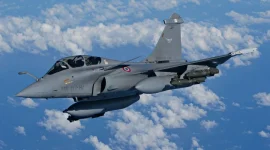- Views: 6K
- Replies: 39
The European consortium behind the Meteor, one of the world's most advanced long-range air-to-air missiles, is reportedly hindering the Indian Air Force's (IAF) plans to integrate the missile onto its frontline fighter jets, including the Su-30MKI, Tejas Mk1A, and the upcoming Tejas MkII. This strategic maneuver appears aimed at bolstering the prospects of European fighter jets in India's upcoming MRFA competition.
Currently, the Meteor is exclusively deployed on the IAF's 36 Rafale jets. Despite the IAF's desire to expand integration to its indigenous Tejas fighters and Russian-origin Su-30MKI fleet, the European consortium, driven by commercial interests, seems reluctant to oblige.
This reluctance stems from the consortium's desire to leverage the Meteor as a unique selling point for the Gripen-E and Eurofighter Typhoon, both vying for India's MRFA tender for 114 new fighter jets. By limiting the Meteor's integration to European platforms, the consortium aims to create a distinct advantage for these contenders in the highly competitive bidding process.
The Meteor missile, renowned for its beyond-visual-range (BVR) capabilities, active radar homing, and ramjet propulsion system, is a game-changer in air combat. Its extended range and sustained speed offer a significant edge in aerial engagements. However, the consortium's restrictive approach could hinder the IAF's efforts to equip its domestically built fighters with this cutting-edge technology, potentially impacting India's pursuit of self-reliance in defence.
In response to this challenge, India is actively developing its own long-range air-to-air missile, the Astra MkIII. This indigenous missile, currently under development by the Defence Research and Development Organisation (DRDO), will also feature ramjet propulsion to enhance its range and engagement capabilities. However, it will likely be several years before the Astra MkIII becomes operational.
The European consortium's stance on Meteor integration adds another layer of complexity to India's MRFA tender. While the IAF seeks to modernize its fleet with advanced weaponry, this restriction may force them to re-evaluate their acquisition strategies. It could also accelerate India's indigenous missile development programs to reduce reliance on foreign suppliers.



